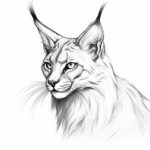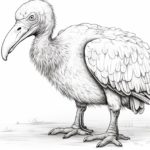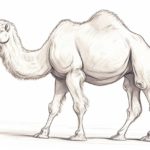Welcome to this step-by-step guide on how to draw a platypus! This fascinating mammal, native to Australia, possesses a unique combination of features, making it a captivating subject for artists. In this tutorial, we will break down the process into easy-to-follow steps, allowing you to create a realistic and charming representation of this extraordinary creature. So, grab your drawing materials and let’s get started!
Materials Required
Before we begin, make sure to gather the following materials:
- Pencil: Use a graphite pencil of your choice, preferably HB or 2B, for sketching and shading.
- Eraser: A soft eraser will come in handy for correcting mistakes and refining your drawing.
- Paper: Select a high-quality drawing paper that can handle pencil work, such as bristol board or heavyweight sketch paper.
- Reference Image: Find a clear and detailed image of a platypus to guide you through the drawing process.
- Optional: Colored pencils or markers if you wish to add a touch of color to your drawing.
Now that you have all your materials ready, let’s dive into the step-by-step process of drawing a platypus!
Step 1: Basic Shapes
Begin by lightly sketching the basic shapes that make up the platypus’s body. Start with an oval shape for the body itself. Then, add a smaller circle on one end for the head and a longer oval shape for the tail. Position these shapes in a way that resembles the natural posture of a platypus.
Step 2: Outlining the Body
Using the basic shapes as a guide, start refining the outline of the platypus’s body. Add curves and contours to depict its rounded body, elongated tail, and small, rounded head. Remember to keep your lines light and loose at this stage, as you will be erasing and refining them later.
Step 3: Facial Features
Now, let’s focus on the platypus’s distinctive facial features. Draw a small, rounded snout at the front of the head circle. Add a curved line to indicate the mouth and a small dot for the eye. Platypuses have a unique bill-like structure, so make sure to capture that characteristic shape.
Step 4: Legs and Webbed Feet
Platypuses have four legs with webbed feet, perfect for swimming. Sketch the front legs first, positioned slightly forward from the body. Use simple curved lines to depict the limbs and add webbing between the toes. Then, draw the hind legs, slightly bent and positioned towards the back. Again, add webbing to the feet.
Step 5: Tail and Fur
Platypuses have a long, tapering tail covered in fur. Extend the oval shape of the tail, tapering it to a point at the end. Add some texture to the tail by lightly sketching short, curved lines to represent fur. Remember to follow the natural direction of the fur, which typically flows towards the tip of the tail.
Step 6: Shading and Texturing
Now that you have the basic outline of the platypus, it’s time to add depth and dimension through shading. Start by identifying the light source in your reference image and imagine how it would interact with the platypus’s body. Use soft, light strokes to shade the areas that are in shadow, gradually building up darker tones.
Pay attention to the platypus’s fur, which has a dense and slightly scruffy texture. Use short, feathery strokes to mimic this texture, focusing on the areas that require more detailing, such as the body and tail. Adjust the pressure on your pencil to achieve varying degrees of darkness and texture.
Step 7: Refine and Erase
Now that the basic structure and shading are complete, take a step back and evaluate your drawing. Look for any areas that need refinement, such as proportion adjustments or any other details you might have missed. Use your eraser to gently remove any stray lines or mistakes, ensuring a clean and polished final result.
Conclusion
Congratulations! You have successfully learned how to draw a platypus from start to finish. By following these step-by-step instructions and taking your time to observe and replicate the unique features of this extraordinary creature, you have created a captivating representation of a platypus on paper. With practice and dedication, your drawing skills will continue to grow, allowing you to tackle more complex subjects in the future.
Remember, drawing is not about achieving perfection right away, but rather about enjoying the process and embracing the learning journey. So keep exploring, experimenting, and honing your artistic skills. We hope you enjoyed this tutorial on how to draw a platypus and feel inspired to create more amazing artworks!
Fun Facts About Platypuses
- Monotremes: Platypuses are one of only five species of monotremes, mammals that lay eggs instead of giving birth to live young. The other monotremes are echidnas, which also inhabit Australia and New Guinea.
- Venomous Spurs: Male platypuses have venomous spurs on their hind legs. While not lethal to humans, the venom can cause intense pain and swelling and is primarily used during competition for mates.
- Duck-Billed: Platypuses are often referred to as duck-billed because of their distinctive, broad, and flat bills. This bill is equipped with electroreceptors that detect the electrical signals generated by the movement of prey in the water.
- Semiaquatic Lifestyle: Platypuses are excellent swimmers and spend much of their time in the water. They have webbed feet and a streamlined body, which helps them navigate through rivers, streams, and lakes.
- Nocturnal and Crepuscular: Platypuses are primarily nocturnal or crepuscular, meaning they are most active during the night or at dawn and dusk. They spend their days resting in burrows dug into the banks of waterways.
- Egg-Laying: Female platypuses lay one to three eggs at a time, which they incubate in a nest made of leaves and grasses. After hatching, the young are nursed by their mother for several months before they are ready to venture out on their own.
- Electrolocation: Platypuses use electrolocation, a unique sense that allows them to detect the electrical fields produced by the muscle contractions of their prey. This helps them hunt for small invertebrates, such as worms, insect larvae, and freshwater crustaceans, in muddy or murky waters.
- Fur and Thermoregulation: Platypuses have dense, waterproof fur that helps keep them warm in the water. They also have a layer of fat beneath their skin for insulation, allowing them to maintain a stable body temperature in cold environments.
- Conservation Status: Platypuses are listed as near threatened by the International Union for Conservation of Nature (IUCN) due to habitat loss, pollution, and the impacts of climate change. Conservation efforts are underway to protect their remaining habitats and populations.
- Cultural Significance: Platypuses hold a special place in Australian culture and folklore, often regarded as iconic symbols of the country’s unique wildlife. They have been featured in literature, art, and popular media, contributing to their status as beloved national treasures.









